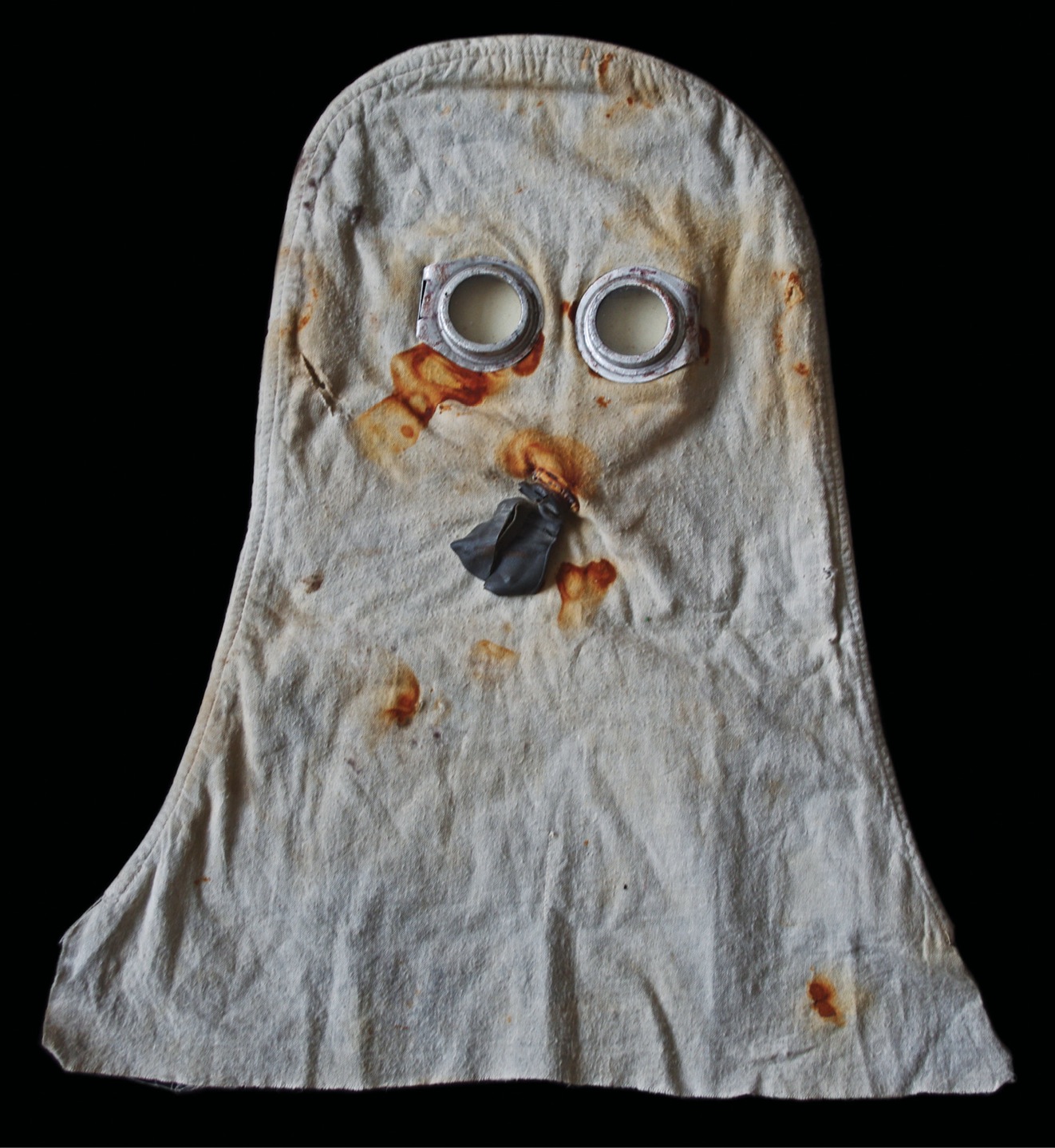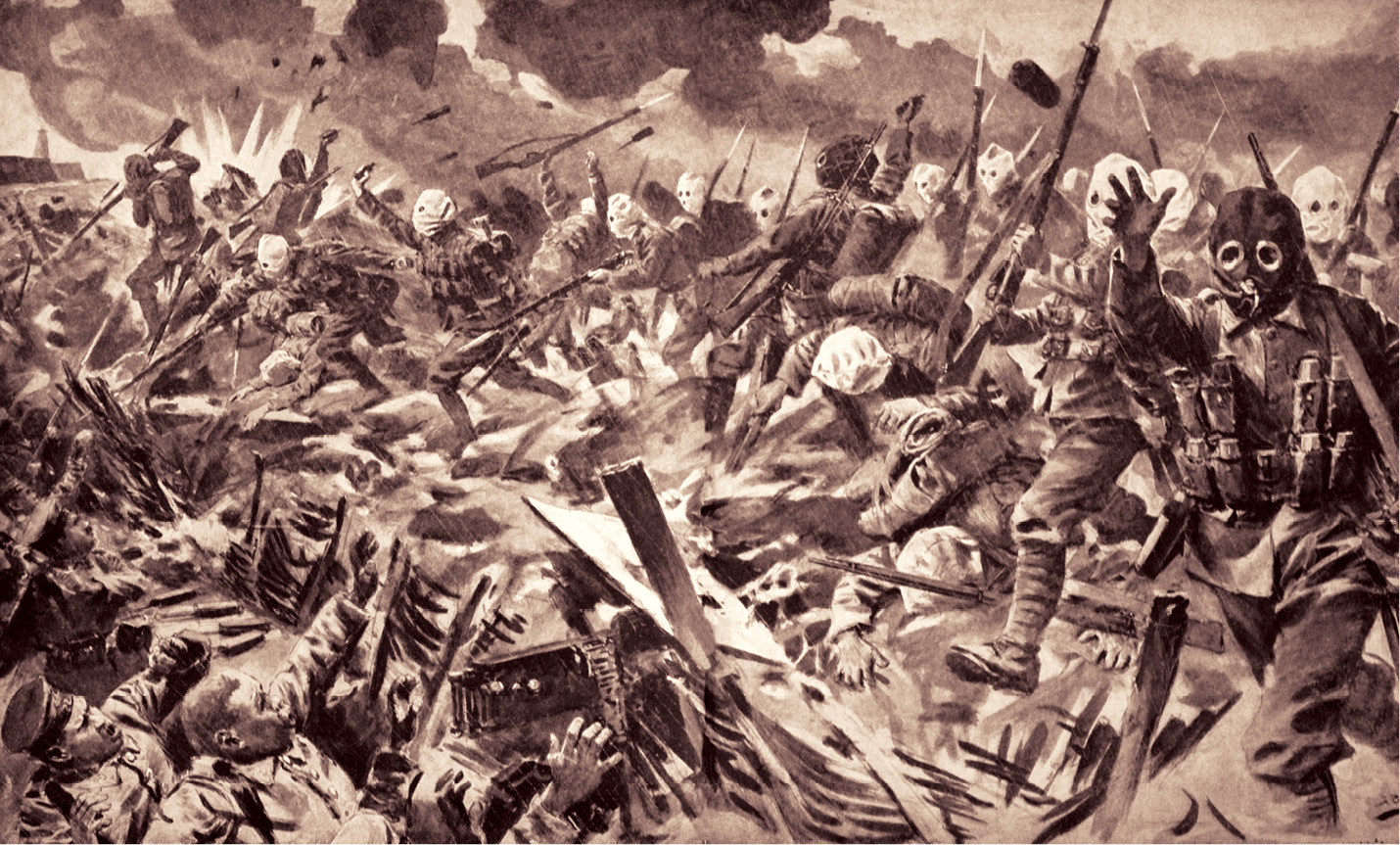51
Gas helmet

THE USE OF gas on April 22, 1915, by the Germans saw the Allies unprepared. As part of their assault at Ypres, the use of chlorine gas released from cylinders was to overcome the unprotected French troops manning the front line, with 800 to 1,400 men killed and a further 2,000 to 3,000 men injured. Chlorine gas kills by irritating the lungs so much that they are flooded, the victims actually drowning in their own body fluids. Men killed by gas show startling blueness of the lips and face, a function of the blood becoming starved of oxygen. Its first use as a weapon was terrifying.
This first use of chemical weapons on the battlefield changed the face of the war; from now on, soldiers would have to be equipped to both defend themselves from the new weapon and understand how it might be used. There would be no turning back from it now. Poison gas was to be used by the British at the Battle of Loos in September 1915, when Lord Kitchener, Secretary of State for War, gave instructions that retaliatory measures be prepared in order to use this weapon against the Germans.
Following the first gas attack, the British had come a long way from their quickly extemporized cloths soaked in alkaline solutions, such as bicarbonate of soda or even urine. Leading chemists quickly identified that a mixture of sodium hyposulphite (“hypo,” as used in photographic processing), sodium carbonate, and glycerine was considered proof against chlorine, bromine, sulfur dioxide, and other fumes—these chemical salts neutralizing the poisons—and the first-issue masks were made of black mourning-veil material and cotton wadding dipped in a solution of the chemicals. The mask was proven to be inadequate by scientists serving as soldiers in the British Expeditionary Force; one of them, Captain Cluny Macpherson, suggested a flannel bag soaked in the same solution that covered the head and was tucked into the top of the uniform jacket. It was also equipped with a mica window. Macpherson’s “Hypo” helmet was issued in early May, but there were still fears that the Hypo helmet would not be proof against the more lethal gases, such as phosgene or hydrogen cyanide. As such, it was replaced by a new pattern, the “P” or “Phenate” helmet, soaked in another counter-gas chemical, sodium phenate; the helmet was made of cotton flannelette, the mica eyepiece was replaced by circular glass eyepieces, and it was fitted with an outlet valve with a tube to be gripped in the teeth. From January 1916 all P helmets were dipped in hexamine—highly absorbent of phosgene gas—to become the phenate-hexamine or “PH” helmet. All were clammy, cloying, and unpleasant to wear. These nightmarish bags were to become part of the iconography of the Great War. Illustrated is the PHG helmet—a version for gunners that ensured the goggles were kept tight to the face with elastic straps, thereby reducing fogging.
At Loos, British soldiers wore both Hypo and P helmets, and were supposed to carry a spare. These nightmarish creations would be famously recorded as the “goggle-eyed bugger with the tit” by Captain Robert Graves of the Royal Welsh Fusiliers. The gas was to be dispensed from cylinders fitted with flexible pipes that connected to the business end of the affair, a 1/2in iron pipe up to 10ft long, and which was fitted with a jet at its end:
Zero hour arrived at last at 5.50 am, and with a redoubled artillery bombardment the gas and smoke were released all along the front. . . . The gas cloud was rolling steadily over towards the German lines. . . . Apart from the artillery drum-fire and the clouds of gas and smoke from eleven thousand candles, twenty-five thousand phosphorous hand-grenades were spurting out dense white fumes.
Lt.-Col. C. H. Foulkes, Commanding RE, Special (Gas) Companies
The British gas attack at Loos had mixed fortunes: the gas refused to travel in some areas, and in others the soldiers became frustrated with the clammy bags and removed them, only to become casualties themselves. Gas was to become commonplace; but with increased capability of countermeasures, its value had diminished. It remains, though, one of the most horrifying weapons ever to have been used on the battlefield.
